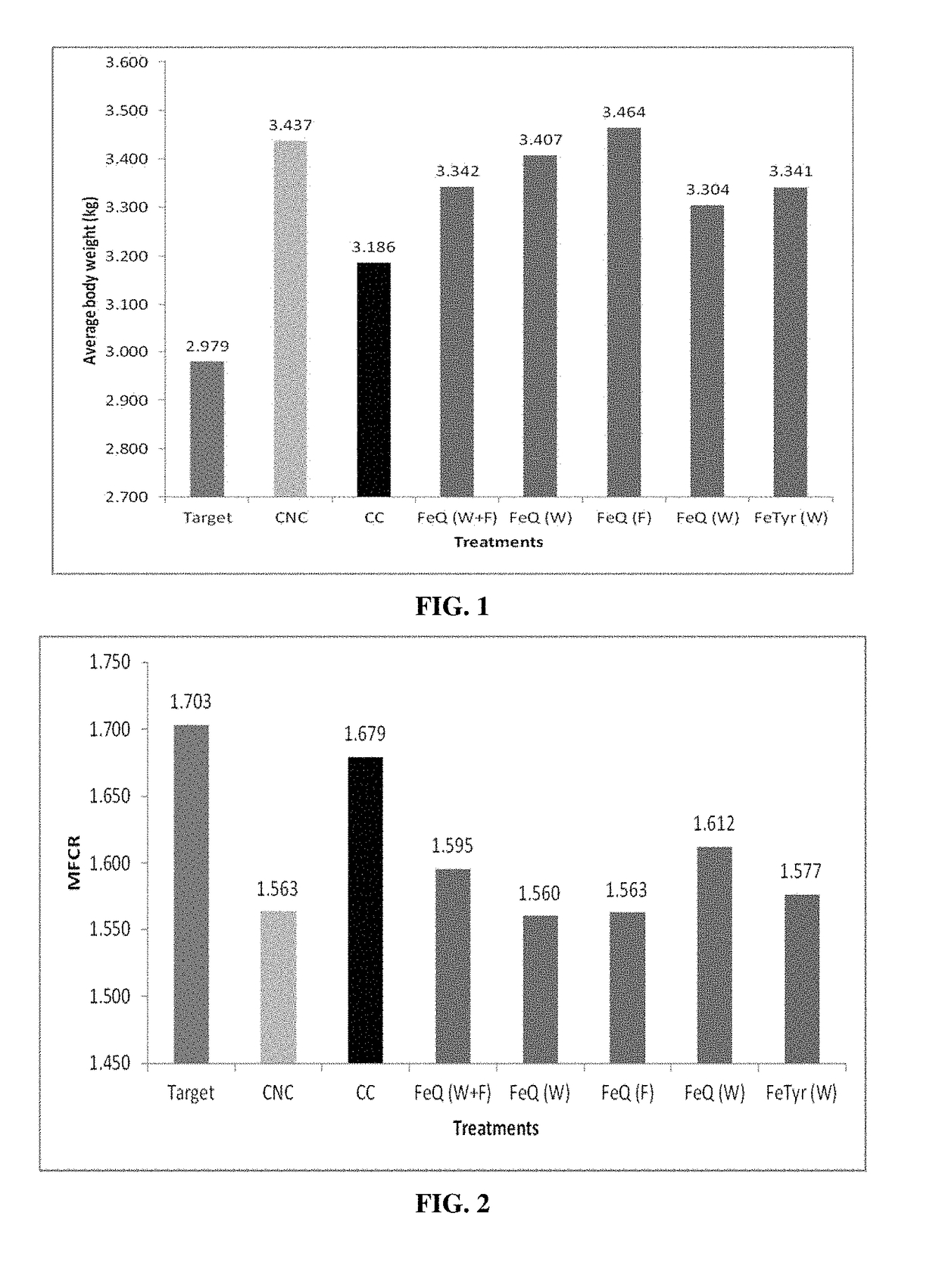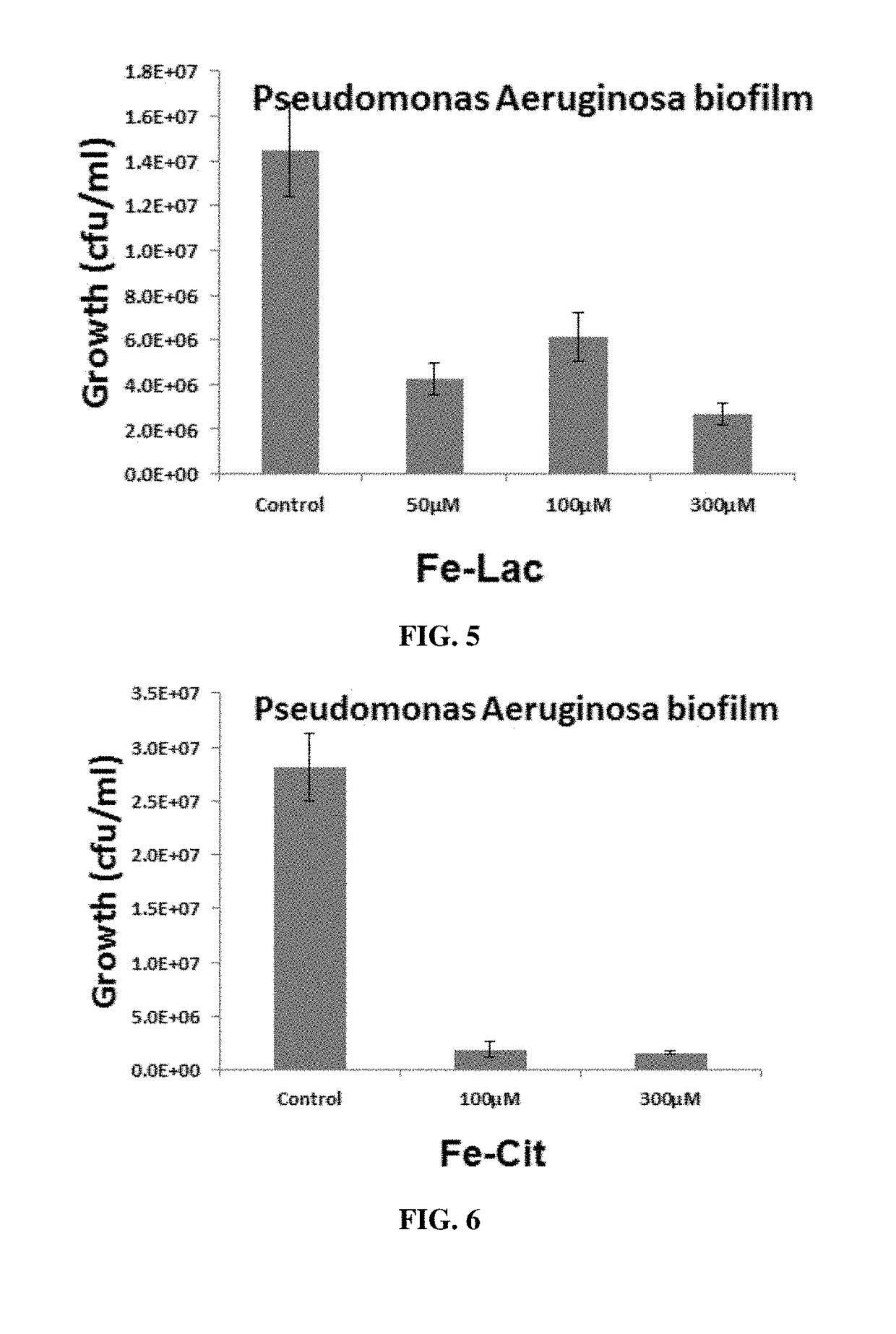Biofilm inhibiting compositions enhancing weight gain in livestock
a composition and composition technology, applied in the field of feed additives, can solve the problems of affecting the consumer, leaving residues in the meat which then impact the consumer, and others are relatively expensive for the amount of gain, so as to improve the growth performance of animals, reduce the conversion ratio of mortality adjusted feed, and increase growth performance
- Summary
- Abstract
- Description
- Claims
- Application Information
AI Technical Summary
Benefits of technology
Problems solved by technology
Method used
Image
Examples
example 7
nt of Weight Gain in Weanling Pigs by Administration of Water Soluble Fe-Complexes
[0532]The objective of this pilot study is to evaluate the effect of three water soluble Fe-complexes (ferric lactate, ferric citrate and ferric tartrate) on growth performance and colonic microbiota of weaner pigs.
[0533]Materials and Methods
[0534]Animal Details[0535]Number of treatments: 4 treatments[0536]Number of replicates: 4 pens[0537]Number of animals per pen: 4 pigs (balanced for sex as much as possible)[0538]Number of pens in study: 16 pens[0539]Animal species and breed: newly weaned pigs (Large White×Landrace)[0540]Total number of animals: 64
[0541]Experimental Design
[0542]There were four (4) treatments, each having 4 replicate pens with 4 pigs per replicate pen, i.e. 16 pigs per treatment or 64 pigs in total. Treatment 1 were control diets, whilst Treatment 2 to 4 were through providing water that includes different Fe-complexes (Table 14).
TABLE 14Experimental treatments and treatment structur...
example 8
n of BioFilm by Iron Complex Compounds—Results Ferric EDTA, Ferric Malate and Ferric Oxalate Hydroxylate Titrations in Clinical Strains from CF Lung Isolate No. 11 from SED Strains'
[0559]Materials and Methods
[0560]Iron Complex Compounds: Ferric EDTA, Ferric Malate and Ferric Oxalate Hydroxylate were tested using clinical strains from CF Lung Isolate No. 11 from SED Strains.
[0561]Sterile beads were placed into 3 ml of Dulbecco's Modified Eagle Medium (DMEM), alongside the desired concentration of the iron-complex and inoculated with PAO SED#11 to OD600 of 0.05. The beads were then incubated at 37° C. for 24 hours.
[0562]The beads were gently washed three times in PBS, placed into 1 ml of PBS and water bath sonicated for 12 minutes. Biofilm on each bead was quantitated by counting colony forming units. The PBS containing biofilm bacterial cells was serially diluted and 10 μl of each dilution was spotted onto LB Agar. These plates were incubated at 30° C. for 24 hours and the colonies w...
example 11
al Efficacy of Ferric Citrate in Rearing Calves
[0581]Materials and Methods
[0582]A study was performed to evaluate the potential of ferric citrate (CI-PLEX™ CHELATE) to improve calf health, welfare, and performance. A total of 80 rearing calves (German Holstein) were used from d 12 to d 68 of age. 40 calves were fed a basal milk replacer (T1 Control). For comparison, 40 calves were fed the basal milk replacer with addition of ferric (III) citrate (T2 CI-PLEX™ CHELATE, 500 g / tonne feed) with a microtracer present at a rate of 10%, equivalent to 50 g / tonne for product identification purposes only. The basal milk replacer was supplemented with ferrous (II) sulfate at normal commercial rates (supplying 85 g Fe / tonne feed). T2 was also supplemented with normal commercial practice of Fe (ferrous (II) sulfate at 85 g Fe / tonne feed) with Fe at 85 g / tonne feed from the ferric (III) citrate (CI-PLEX™ CHELATE). No diet exceeded the maximum EU permitted Fe for rearing calf feeds. The treatments ...
PUM
 Login to View More
Login to View More Abstract
Description
Claims
Application Information
 Login to View More
Login to View More - R&D
- Intellectual Property
- Life Sciences
- Materials
- Tech Scout
- Unparalleled Data Quality
- Higher Quality Content
- 60% Fewer Hallucinations
Browse by: Latest US Patents, China's latest patents, Technical Efficacy Thesaurus, Application Domain, Technology Topic, Popular Technical Reports.
© 2025 PatSnap. All rights reserved.Legal|Privacy policy|Modern Slavery Act Transparency Statement|Sitemap|About US| Contact US: help@patsnap.com



